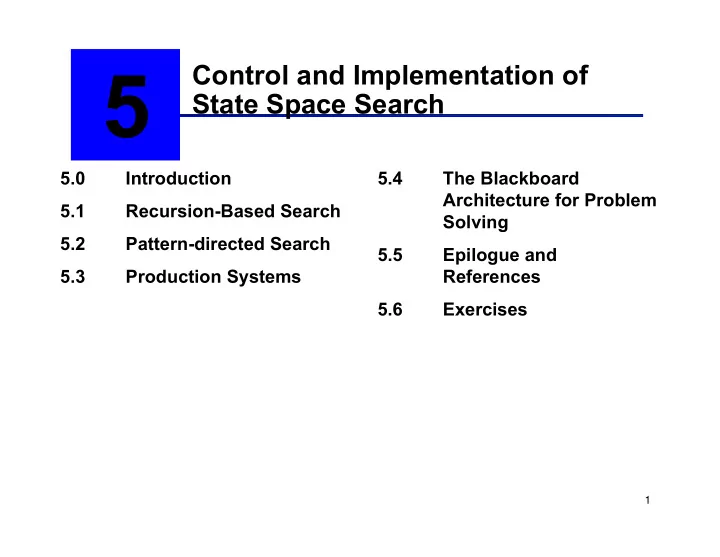

5 Control and Implementation of State Space Search 5.0 Introduction 5.4 The Blackboard Architecture for Problem 5.1 Recursion-Based Search Solving 5.2 Pattern-directed Search 5.5 Epilogue and 5.3 Production Systems References 5.6 Exercises 1
Chapter Objectives • Compare the recursive and iterative implementations of the depth-first search algorithm • Learn about pattern-directed search as a basis for production systems • Learn the basics of production systems • The agent model: Has a problem, searches for a solution, has different ways to model the search 2
Summary of previous chapters • Representation of a problem solution as a path from a start state to a goal • Systematic search of alternative paths • Backtracking from failures • Explicit records of states under consideration open list: untried states • closed lists: to implement loop detection • • open list is a stack for DFS, a queue for BFS 3
Function depthsearch algorithm 4
Use recursion • for clarity, compactness, and simplicity • call the algorithm recursively for each child • the open list is not needed anymore, activation records take care of this • still use the closed list for loop detection 5
Function depthsearch (current_state) algorithm 6
Pattern-directed search • use modus ponens on rules such as q(X) → p(X) • if p(a) is the original goal, after unification on the above rule, the new subgoal is q(a) 7
A chess knight’s tour problem Legal moves of a knight Move rules 9
Examples • Is there a move from 1 to 8? Pattern_search(move(1,8)) success • Where can the knight move from 2? Pattern_search(move(2,X)) {7/X}, {9/X} • Can the knight move from 2 to 3? Pattern_search(move(2,3)) fail • Where can the knight move from 5? Pattern_search(move(5,X)) fail 10
2 step moves • ∀ X,Y [path2(X,Y) ← ∃ Z [move(X,Z) ∧ move(Z,Y)]] • path2(1,3)? • path2(2,Y)? 11
3 step moves • ∀ X,Y [path3(X,Y) ← ∃ Z,W [move(X,Z) ∧ move(Z,W) ∧ move(W,Y]] • path3(1,2)? • path3(1,X)? • path3(X,Y)? 12
General recursive rules • ∀ X,Y [path(X,Y) ← ∃ Z [move(X,Z) ∧ path(Z,Y)]] • ∀ X path(X,X) 13
Generalized pattern_search • if the current goal is negated call pattern_search with the goal and return success if the call returns failure • if the current goal is a conjunction call pattern_search for all the conjuncts • if the current goal is a disjunction call pattern_search for all the disjuncts until one returns success 14
A production system is defined by: • A set of production rules (aka productions ): condition-action pairs. • Working memory : the current state of the world • The recognize-act cycle : the control structure for a production system Initialize working memory Match patterns to get the conflict set ( enabled rules ) Select a rule from the conflict set ( conflict resolution ) Fire the rule 15
A production system 16
Trace of a simple production system 17
The 8-puzzle as a production system 18
Production system search with loop detection & depth bound 5 (Nilsson, 1971) 19
A production system solution to the 3 × 3 knight’s tour problem 20
The recursive path algorithm: a production system 21
Data-driven search in a production system 22
Goal-driven search in a production system 23
Bidirectional search misses in both directions: excessive search 24
Bidirectional search meets in the middle 25
Advantages of production systems Separation of knowledge and control A natural mapping onto state space search Modularity of production rules Pattern-directed control Opportunities for heuristic control of search Tracing and explanation Language independence A plausible model of human problem solving 26
Comparing search models Given a start state and a goal state • State space search keeps the “current state” in a “node”. Children of a node are all the possible ways an operator can be applied to a node • Pattern-directed search keeps the all the states (start, goal, and current) as logic expressions. Children of a node are all the possible ways of using modus ponens. • Production systems keep the “current state” in “working memory.” Children of the current state are the results of all applicable productions. 27
Variations on a search theme • Bidirectional search: Start from both ends, check for intersection (Sec. 5.3.3). • Depth-first with iterative deepening: implement depth first search using a depth- bound . Iteratively increase this bound (Sec. 3.2.4). • Beam search: keep only the “best” states in OPEN in an attempt to control the space requirements (Sec. 4.4). • Branch and bound search: Generate paths one at a time, use the best cost as a “bound” on future paths, i.e., do not pursue a path if its cost exceeds the best cost so far (Sec. 3.1.2). 28
Recommend
More recommend